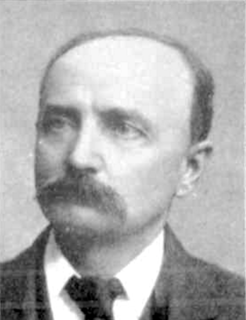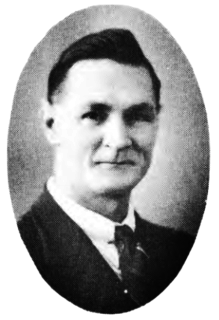Related Research Articles
The Electoral district of Brown Hill-Ivanhoe was a Legislative Assembly electorate in the state of Western Australia. It covered part of the Goldfields city of Boulder, near Kalgoorlie, and neighbouring mining areas. It was created at the 1911 redistribution out of the former seats of Brown Hill and Ivanhoe, and was first contested at the 1911 election. It was abolished in the 1948 redistribution, with its area split between the neighbouring electorates of Boulder and Hannans, taking effect from the 1950 election. The seat was a very safe one for the Labor Party.

Albert Redvers George Hawke was the 18th Premier of Western Australia. He served from 23 February 1953 to 2 April 1959, and represented the Labor Party.

John Collings Willcock was the 15th Premier of Western Australia, serving from 1936 until 1945. He was a member of the Austrailian Labor Party.
Eyre was an electoral district of the Legislative Assembly of Western Australia. It was in existence for three separate periods, on each occasion covering large portions of south-eastern Western Australia. Eyre was a safe seat for the Labor Party in its first two incarnations, but during its third incarnation was a marginal seat between the Liberal Party and the National Party.
This is a list of members of the Western Australian Legislative Assembly between the 1939 election and the 1943 election, together known as the 17th Parliament.
This is a list of members of the Western Australian Legislative Assembly between the 1930 election and the 1933 election, together known as the 14th Parliament. It took place under radically altered boundaries as enacted within the Redistribution of Seats Act 1929, whose effect had been exaggerated by the lack of a redistribution for the previous 18 years. The gold mining areas, populous at the time of the 1911 redistribution, had been reduced to pocket boroughs by the decline in gold mining as an economic activity in the State; meanwhile, the agricultural and metropolitan areas had grown substantially. Ironically, the changes were enacted by a Labor government even though most of the safe seats being abolished were Labor seats—and for the fourth time in a row, the government enacting the redistribution lost the subsequent election.
This is a list of members of the Western Australian Legislative Assembly between the 1936 election and the 1939 election, together known as the 16th Parliament.

Elections were held in the state of Western Australia on 20 November 1943 to elect all 50 members to the Legislative Assembly. The Labor Party, led by Premier John Willcock, won a fourth term in office against the Country and Nationalist parties, led by Opposition Leader Arthur Watts and Robert Ross McDonald respectively.

Elections were held in the state of Western Australia on 8 April 1933 to elect all 50 members to the Legislative Assembly. The one-term Nationalist-Country coalition government, led by Premier Sir James Mitchell, was defeated by the Labor Party, led by Opposition Leader Philip Collier.

The Second Collier Ministry was the 18th Ministry of the Government of Western Australia and was led by Labor Premier Philip Collier. It succeeded the Second Mitchell Ministry on 24 April 1933, following the defeat of the Nationalist government at the 1933 election on 8 April.

Robert "Bob" Hastie was an Australian politician who was the first parliamentary leader of the Labour Party in Western Australia. He was a member of the state's Legislative Assembly from 1901 to 1905.
Aloysius Joseph "Loy" Rodoreda was an Australian politician who was the Speaker of the Legislative Assembly of Western Australia from 1953 to 1956. A member of the Labor Party, he sat in parliament from 1933 to his death in 1958, first representing Roebourne and then Pilbara, both located in the state's North-West.
William Hegney was an Australian politician who was a Labor Party member of the Legislative Assembly of Western Australia from 1939 to 1968. He served as a minister in the government of Albert Hawke.

Aubrey Augustus Michael Coverley was an Australian politician who was a Labor Party member of the Legislative Assembly of Western Australia from 1924 until his death, representing the seat of Kimberley. He served as a minister in the governments of John Willcock and Frank Wise.
Selby Walter Munsie was an Australian politician who was a Labor Party member of the Legislative Assembly of Western Australia from 1911 until his death, representing the seat of Hannans. He served as a minister in the governments of Philip Collier and John Willcock.
William Mortimer Marshall was an Australian politician who was a Labor Party member of the Legislative Assembly of Western Australia from 1921 until his death, representing the seat of Murchison. He served as a minister in the government of Frank Wise.
William Hawkins Sewell was an Australian politician who was a Labor Party member of the Legislative Assembly of Western Australia from 1950 to 1974, representing the seat of Geraldton.
Herbert Henry Styants was an Australian politician who was a Labor Party member of the Legislative Assembly of Western Australia from 1936 to 1956, representing the seat of Kalgoorlie. He served as a minister in the government of Albert Hawke.
John Joseph Brady was an Australian trade unionist and politician who was a Labor Party member of the Legislative Assembly of Western Australia from 1948 to 1974. He served as a minister in the government of Albert Hawke.
Frederick Charles Lee Smith was an Australian trade unionist, journalist, and politician who was a Labor Party member of the Legislative Assembly of Western Australia from 1932 to 1950, representing the seat of Brown Hill-Ivanhoe. He served as a minister in the government of John Willcock.
References
- 1 2 3 4 Emil Nulsen – Biographical Register of Members of the Parliament of Western Australia. Retrieved 2 June 2016.
- ↑ "MR. EMIL NULSEN", The Sunday Times (Perth, Western Australia), 16 April 1933.
- 1 2 Black, David; Prescott, Valerie (1997). Election statistics : Legislative Assembly of Western Australia, 1890-1996. Perth, [W.A.]: Western Australian Parliamentary History Project and Western Australian Electoral Commission. ISBN 0730984095.